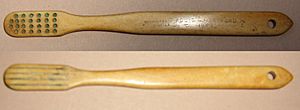SS Breda facts for kids
class="infobox " style="float: right; clear: right; width: 315px; border-spacing: 2px; text-align: left; font-size: 90%;"
| colspan="2" style="text-align: center; font-size: 90%; line-height: 1.5em;" |
|}
Bone toothbrush found on SS Breda. The inscription reads "WARRANTED PURE BRISTLE" "ADDIC HERTFORD 1940"
The SS Breda was a large Dutch ship. It was designed to carry both cargo and passengers. This ship became famous because it was sunk in Scotland during World War II. Today, it is a popular spot for divers to explore.
Contents
| History | |
|---|---|
| Name | SS Breda |
| Namesake | Breda |
| Owner | Koninklijke Nederlandsche Stoomboot Maatschappij |
| Builder | Nieuwe Waterweg Scheepsbouwmaatschappij, Schiedam |
| Laid down | 16 December 1919 |
| Launched | 2 July 1921 |
| Completed | 10 December 1921 |
| Identification | Call sign: PDGH |
| Fate | Bombed and sunk, 23/24 December 1940 |
| General characteristics | |
| Type | Cargo-passenger ship |
| Tonnage |
|
| Length | 122.69 m (402 ft 6 in) |
| Beam | 17.78 m (58 ft 4 in) |
| Depth | 7.25 m (23 ft 9 in) |
| Propulsion |
|
| Speed | 15 knots (28 km/h; 17 mph) |
| Armament | 1 × 4.7 in (119 mm) gun (1940) |
Building the Breda
The Breda was built in a shipyard called Nieuwe Waterweg Scheepsbouwmaatschappij. This shipyard was located in Schiedam, a city in the Netherlands. The ship was made for the Koninklijke Nederlandsche Stoomboot Maatschappij, which means "Royal Netherlands Steamship Company".
Work on the ship started on December 16, 1919. It took a while to build, and the ship was finally launched into the water on July 2, 1921. The Breda was completed and ready for use on December 10, 1921.
Ship's Size and Power
The Breda was a big ship. It weighed about 6,941 gross tons. It was about 122.69 meters (402 feet) long. The ship was also 17.78 meters (58 feet) wide.
To make it move, the Breda had two powerful steam turbine engines. These engines allowed the ship to travel at a top speed of 15 knots. The ship had five large areas for cargo. It could also carry up to 87 passengers.
The Breda's Journey and Sinking
In May 1940, during World War II, the Netherlands was invaded. The Breda quickly sailed to Britain to escape. There, it was put under the control of the P&O Line, a British shipping company. To help with the war effort, the ship was fitted with a large 4.7-inch gun.
On December 23, 1940, the Breda was waiting near Oban, Scotland. It was part of a group of ships forming a convoy. This convoy was getting ready to sail all the way to Bombay, India.
What the Ship Carried
The Breda was carrying a lot of different items. Its cargo included 3,000 tons of cement and 175 tons of tobacco and cigarettes. It also had military vehicles, like Army lorries.
There were also airplanes on board, including three Hawker and 30 de Havilland Tiger Moth biplanes. Other items included copper, rubber sandals, and special paper for banknotes. The ship even carried 10 horses and nine dogs!
The Attack
As evening came on December 23, 1940, German Heinkel He 111 bombers attacked. These planes had flown all the way from Norway. They dropped four 250-kilogram (550-pound) bombs near the Breda.
The explosions were very strong. They broke a pipe that let water into the ship. The engine room quickly filled with water, and the ship lost all power.
Sinking of the Breda
Workers quickly tried to save the ship. They towed it to shallow water in Ardmucknish Bay. They started to unload some of its cargo. However, the next day, a big storm hit. The storm pushed the Breda into deeper water.
The ship then sank to a depth of about 26 meters (85 feet). Its exact location is 56°28′32″N 5°25′04″W.
The Breda Today
Even though it sank, the Breda is still important. It has become a very popular place for wreck diving. Divers can explore the ship and see the cargo that remains. Buoys mark the site to help divers find it easily.


